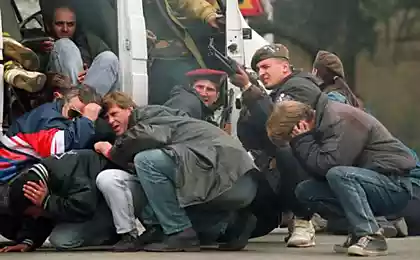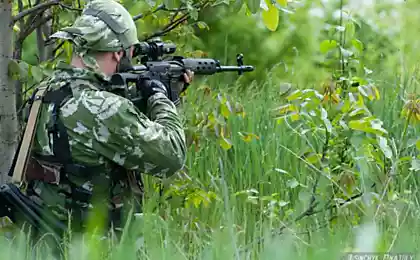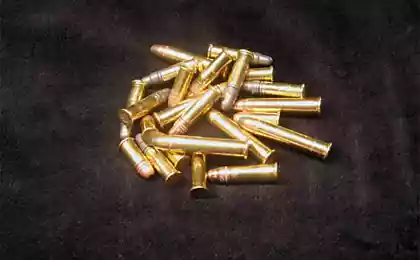1170
Slavic and medieval weapons (20+ ph)
Link
Mace
Mace emerged with the development of knight's armor in the West that Mace could not cut through. Gradually chapter, and often the shaft were made of iron or steel, steel Invite someone to cover the individual standing ribs increases the specific load at impact. These clubs were called mace.
German, Balkan maces (morningstar).

German clubs (morningstar).
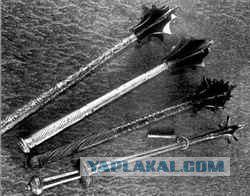
German clubs (Shestoperov) 1500.
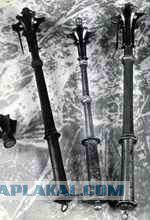
Dobavleno1 in [mergetime] 1257261924 [/ mergetime]
Russian mace - in Russia believe why it is not combat, and an honorary weapon, mace word appears in the earliest acts of Russian 16th century, while in Europe it was used widely in the 15th century. Mace is the actual metal mace with more explicit part of the shock. Sometimes mace dot the island and then called buzdyhanom. Most Western Morgenstern "Morning Star" is still the 15th century was just such a device. In general, the mace and the word, and the word buzdyhan eastern origin, so it must be assumed that these weapons do not come to Russia from the West and from the East. Varieties were maces and mace cant just copied from Western models. Mace head was (drum part) consisting of an edge set of metal plates (feathers). If the feathers were six weapons called Shestoperov, sometimes it was given the name and the large number of feathers.
Swords
Dobavleno1 in [mergetime] 1257261986 [/ mergetime]
In the history of arms in Europe, there is no period that would have a greater value than the period of 10-11 centuries. The reason is the northern people Normans "Vikings" (future Danes, Swedes, Norwegians). In addition to the long axes and replica weapons Norman was a long sword. Interestingly, in the arms of the Normans themselves had a significant impact oriental weapons, as in military campaigns were held across Europe landed on the African coast and even served at the Byzantine court. The Normans enthusiastically seized on the idea of the conquest of the Holy Land, and more inclined to the French. The soldiers with the Saracens were adopted many kinds of oriental weapons. Under the direction of Charlemagne's Frankish-German government reaches a high degree of power, formed the class of knights. It formed the notion of "higher" ie sitting on a horse and "low" ie, standing on the ground. Long Sword become the main weapon mounted warrior, ie free man.
From bottom to top, German, Tatar, Kalmyk, Hungarian clubs (Shestoperov).

Western European swords 1100

Sword Master Conrad 1240

Zapadnoevropeskie swords 1250

Western European sword.
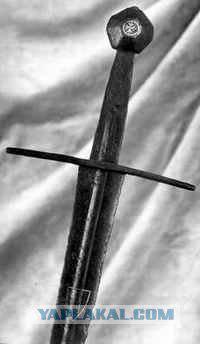
In the 13th century, used as a straight or curved shape of sword handles.
Sword master of the Teutonic Order, Hermann Salza, 13th century
By the beginning of the 14th century the military had found two swords of different sizes. Not smaller than the entire length of one meter. For increased power due to the wide spread of armor began to use long swords raised a fortress, with a sharp triangular often suitable for hiking and fight. This double-edged two-handed swords, the blade length of at least 1, 2 meters to prevent the loss of the sword in battle, sword to the head begin to attach a long chain or leather bindings, which is the other end fastened to gambizonu (see. Armor). Another chain was attached for the same purpose to the dagger. However, by early in the 15th century swords with chain fell out of use.

Western European swords around 1350-1400 years

Western European swords around 1400- 1450 year.

Knights 14th-15th centuries, armed saddle sword (epee d 'arcon), nosivshemsya on pommel (arcon), the blade of a sword has a length of up to 1 m. The double-edged sword of this type was a two-handed in connection with what had divided into Two handle recesses. Sometimes, like a sword, and he was made one and a half hands.

Some of the swords of the first half of the 15th century, already have the ring finger, or at least attempts to devices such rings are becoming more frequent. Handle Levantine Dagi total length of 0, 95 m, also forms a ring at the crossroads (Gard). The appointment of such a ring is not completely established, it is believed that such a ring is not intended to place the fingers and hanging Dagi the armor or saddle.

Italian sandedei (sandedei, cinque dea) (chinkvedei) and incorrectly called linqua di bue (ox tongue), in principle, not swords and Dagi (daggers), but their length in some cases inferior to the length of the short swords (60 cm). The handle is usually made of invoice from bone or wood. Large sandedei be regarded as swords. Sandedei usually served not combat, and parade and hunting weapons.

Italian chinkvedei (sandedei), 1500. First left work Ercole de Fidel. Blades highly artistic decorated with drawings and inscriptions.
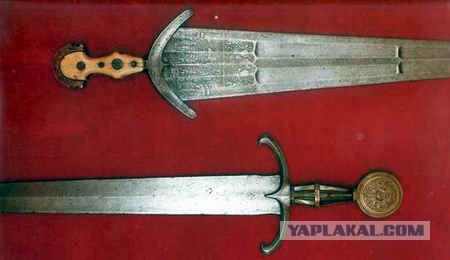
Long Swords German landsknehtov1520 year. Sticks and blades artistically decorated with drawings and inscriptions. A typical German infantry weapon was a short sword (sword) or kattsbalger -lansknetta (koshkoder) with a wide blade crosshairs (guard) which is formed by two curved arches in the form of two lateral rings. The length of the average of weapons did not exceed 70 cm. The sheath had a tip and made of leather or colored cloth. Lansknettu worn on a belt horizontally directing the handle to the right, so that all the weapons lying across the abdomen. Kattsbalgery used and large two-handed blade more than one meter.

Highly artistic crossroads of the German sword 1555-1560 period. Master Yang Kollert

Ephesus and the sheath of the sword of the German master Joerg Zigman1562g.

In the 16th century, the sword reaches the highest degree of perfection. Simple handle in the form of a cross slope to destruction; we barely find this form in the saddle long sword estoque (estoc) cavalry. Estoque is not used as a slashing and piercing weapons designed for penetration committed by the time the armor. Estoque had largely uploshenny diamond-shaped in cross-section blade able to move in by the end of such a powerful trihedral awl. For the same purpose served German pantsershtehery have tregranny blade with emarginate dales on the sides. So the sword in principle could apply chop, but its effectiveness in comparison with the thrusting action of naturally became small. Venetian sword with a blade length of about one meter in cross section resembles a flattened rhombus may serve as an illustration of the latter types of swords.

From left to right samples of the West European weapons 1600s. German sword, the Spanish sword, transitional types of weapons that can be classified as batardy (batarde), or types of Saxon sword.

Now Mace
Maces old West European weapons are usually made of wood on which jammed nails or iron tip. Gradually they began to make a club with a lag shoulders, mimicking the seeds of umbrella plant found in Western Europe. These maces were used from the 13th century to the 17th century. Mace fought the poorest soldiers and knights, which is more like another weapon.
From the bottom up, Western maces "Morgenstern" combat flail flail battle "Morgenstern".
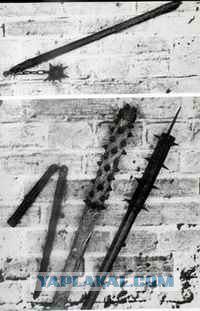
Types maces "Morgenstern", fitted as part of a stabbing.

Dobavleno1 in [mergetime] 1257263070 [/ mergetime]
Russian Mace (Bludgeon) - Mace called rough wooden club, one end of which is designed to strike often studded with iron nails or okovyvalsya iron. Bludgeon armed poorest walking warriors.
(it is not in the picture)
Type maces "Morgenstern" and type from without.

Slavic Swords X-XII centuries
Unlike saber sword was typical of Russian weapons and intended for chopping at least - thrusting. It is expensive, unique piece of weaponry, often passed from father to son.
Production of special swords were very developed area of medieval crafts. Each sword passed through many hands: harvesting operations metal band stretching, polishing, tempering, sharpening blades, nozzle handle, manufacture sheath occupies a separate specialist. The samples were found by archeologists allow you to specify the major changes swords X-XII centuries: the blade length of about 100 cm, or slightly more than the width of 4 to 6 cm, the average of the width of 4 - 6 cm, the middle part of the blade thickness of 2, 5 - 3 to 4 - 6 mm.
Arab writers of the time pointed out that the ancient Russians always carry swords - flat, grooved, broad at the hilt, narrow at the tip - and see them as a means of livelihood, Fighting them at the trial. at the conclusion of contracts they are also sworn swords and shields.
"Zaitov sword" meant to conquer the city or countryside. "Vzaimat sword against" meant to start a war.
In the picture: A), B) Swords IX-XII centuries from Ust - Rybezhki and streams. B) Hallmarks swords D) The handle of the sword: the knob - "apple", the handle - "is black", crosshairs - "steel" from Brooks.
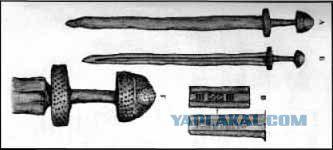
Partisan
Partisan (pertuisane) - kind of spear with a wide blade and the ears of various sizes. He served for injection. In the most ancient Protazanov ears blade extremely small quantities. Use Protazanov begins in the West before the 15th century, it is constantly mixed with a halberd widely varying options of halberds it differs primarily by the presence of symmetrical ears.
Trabantskie and Italian partisan 1510-1588 period.

Saxon partisan XVII century
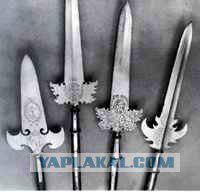
In the 17th century, during an appearance on Russia Falsdmitry with the Polish army and the "foreign formation of regiments," we borrowed in the West and partisan. In Russia was exceptionally honorable partisan weapon.
Artistic blade German partisan 1675.

From without
Western European weapons from without (vouge, gleve) there has been a sharp long blade adapted for injection and for the chop. Spit it straightened from without, in this gun should look for its origin. From without is often supplied in the direction of a variety of hooks designed to throw the rider off his horse. Siege knife (couteau de breche) has approximately the same shape; this weapon was used mainly in Germany, where it is stored until the 18th century. Oxen language (langue de boeuf, lingua di bue) is a weapon with the shaft or the dagger, whichever he planted on the shaft or handle handguns. If it is to the shaft, the plate is at a distance of about 15 cm. From the wide and flat blade.
German from without 1577-1612 period.

On each side of the Italian halberd, in the center of the German from without the years 1551-1567.

Italian from without of the 16th century.
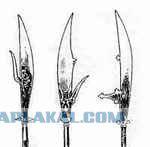
Saxon from without.

Hammer with a beak
Gavel (klevets- mateau d, frmes, picois) a relatively light metal hammer with a pointed beak-shaped. Russian coinage is no different from Western European warhammer destined for the West punching heavy knight's armor. In the West, there were chased, with completely different beak forms (a, bec), for example, the falcon, the parrot, the crow, heron.
German battle hammers with its beak (Klevtsov) and German mace
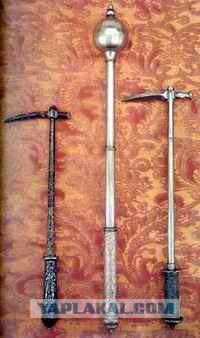
More hammers

Guisarme
Guisarme had the sharp curved blade, both with one or two blades, the lateral bayonet is usually not performed on the length of the blade or was shorter. Generally guisarme blade was used to cut podzhilok horses, and direct the tip was intended to apply injections. guisarme, haymakers and later godendakami from them there was a halberd.
Dobavleno1 in [mergetime] 1257264083 [/ mergetime]
You can post komenty, I'm hardly going to something else to add, since it is easier to use the link on the 1st page)

Source:
Mace
Mace emerged with the development of knight's armor in the West that Mace could not cut through. Gradually chapter, and often the shaft were made of iron or steel, steel Invite someone to cover the individual standing ribs increases the specific load at impact. These clubs were called mace.
German, Balkan maces (morningstar).

German clubs (morningstar).

German clubs (Shestoperov) 1500.

Dobavleno1 in [mergetime] 1257261924 [/ mergetime]
Russian mace - in Russia believe why it is not combat, and an honorary weapon, mace word appears in the earliest acts of Russian 16th century, while in Europe it was used widely in the 15th century. Mace is the actual metal mace with more explicit part of the shock. Sometimes mace dot the island and then called buzdyhanom. Most Western Morgenstern "Morning Star" is still the 15th century was just such a device. In general, the mace and the word, and the word buzdyhan eastern origin, so it must be assumed that these weapons do not come to Russia from the West and from the East. Varieties were maces and mace cant just copied from Western models. Mace head was (drum part) consisting of an edge set of metal plates (feathers). If the feathers were six weapons called Shestoperov, sometimes it was given the name and the large number of feathers.
Swords
Dobavleno1 in [mergetime] 1257261986 [/ mergetime]
In the history of arms in Europe, there is no period that would have a greater value than the period of 10-11 centuries. The reason is the northern people Normans "Vikings" (future Danes, Swedes, Norwegians). In addition to the long axes and replica weapons Norman was a long sword. Interestingly, in the arms of the Normans themselves had a significant impact oriental weapons, as in military campaigns were held across Europe landed on the African coast and even served at the Byzantine court. The Normans enthusiastically seized on the idea of the conquest of the Holy Land, and more inclined to the French. The soldiers with the Saracens were adopted many kinds of oriental weapons. Under the direction of Charlemagne's Frankish-German government reaches a high degree of power, formed the class of knights. It formed the notion of "higher" ie sitting on a horse and "low" ie, standing on the ground. Long Sword become the main weapon mounted warrior, ie free man.
From bottom to top, German, Tatar, Kalmyk, Hungarian clubs (Shestoperov).

Western European swords 1100

Sword Master Conrad 1240

Zapadnoevropeskie swords 1250

Western European sword.

In the 13th century, used as a straight or curved shape of sword handles.
Sword master of the Teutonic Order, Hermann Salza, 13th century
By the beginning of the 14th century the military had found two swords of different sizes. Not smaller than the entire length of one meter. For increased power due to the wide spread of armor began to use long swords raised a fortress, with a sharp triangular often suitable for hiking and fight. This double-edged two-handed swords, the blade length of at least 1, 2 meters to prevent the loss of the sword in battle, sword to the head begin to attach a long chain or leather bindings, which is the other end fastened to gambizonu (see. Armor). Another chain was attached for the same purpose to the dagger. However, by early in the 15th century swords with chain fell out of use.

Western European swords around 1350-1400 years

Western European swords around 1400- 1450 year.

Knights 14th-15th centuries, armed saddle sword (epee d 'arcon), nosivshemsya on pommel (arcon), the blade of a sword has a length of up to 1 m. The double-edged sword of this type was a two-handed in connection with what had divided into Two handle recesses. Sometimes, like a sword, and he was made one and a half hands.

Some of the swords of the first half of the 15th century, already have the ring finger, or at least attempts to devices such rings are becoming more frequent. Handle Levantine Dagi total length of 0, 95 m, also forms a ring at the crossroads (Gard). The appointment of such a ring is not completely established, it is believed that such a ring is not intended to place the fingers and hanging Dagi the armor or saddle.

Italian sandedei (sandedei, cinque dea) (chinkvedei) and incorrectly called linqua di bue (ox tongue), in principle, not swords and Dagi (daggers), but their length in some cases inferior to the length of the short swords (60 cm). The handle is usually made of invoice from bone or wood. Large sandedei be regarded as swords. Sandedei usually served not combat, and parade and hunting weapons.

Italian chinkvedei (sandedei), 1500. First left work Ercole de Fidel. Blades highly artistic decorated with drawings and inscriptions.

Long Swords German landsknehtov1520 year. Sticks and blades artistically decorated with drawings and inscriptions. A typical German infantry weapon was a short sword (sword) or kattsbalger -lansknetta (koshkoder) with a wide blade crosshairs (guard) which is formed by two curved arches in the form of two lateral rings. The length of the average of weapons did not exceed 70 cm. The sheath had a tip and made of leather or colored cloth. Lansknettu worn on a belt horizontally directing the handle to the right, so that all the weapons lying across the abdomen. Kattsbalgery used and large two-handed blade more than one meter.

Highly artistic crossroads of the German sword 1555-1560 period. Master Yang Kollert

Ephesus and the sheath of the sword of the German master Joerg Zigman1562g.

In the 16th century, the sword reaches the highest degree of perfection. Simple handle in the form of a cross slope to destruction; we barely find this form in the saddle long sword estoque (estoc) cavalry. Estoque is not used as a slashing and piercing weapons designed for penetration committed by the time the armor. Estoque had largely uploshenny diamond-shaped in cross-section blade able to move in by the end of such a powerful trihedral awl. For the same purpose served German pantsershtehery have tregranny blade with emarginate dales on the sides. So the sword in principle could apply chop, but its effectiveness in comparison with the thrusting action of naturally became small. Venetian sword with a blade length of about one meter in cross section resembles a flattened rhombus may serve as an illustration of the latter types of swords.

From left to right samples of the West European weapons 1600s. German sword, the Spanish sword, transitional types of weapons that can be classified as batardy (batarde), or types of Saxon sword.

Now Mace
Maces old West European weapons are usually made of wood on which jammed nails or iron tip. Gradually they began to make a club with a lag shoulders, mimicking the seeds of umbrella plant found in Western Europe. These maces were used from the 13th century to the 17th century. Mace fought the poorest soldiers and knights, which is more like another weapon.
From the bottom up, Western maces "Morgenstern" combat flail flail battle "Morgenstern".

Types maces "Morgenstern", fitted as part of a stabbing.

Dobavleno1 in [mergetime] 1257263070 [/ mergetime]
Russian Mace (Bludgeon) - Mace called rough wooden club, one end of which is designed to strike often studded with iron nails or okovyvalsya iron. Bludgeon armed poorest walking warriors.
(it is not in the picture)
Type maces "Morgenstern" and type from without.

Slavic Swords X-XII centuries
Unlike saber sword was typical of Russian weapons and intended for chopping at least - thrusting. It is expensive, unique piece of weaponry, often passed from father to son.
Production of special swords were very developed area of medieval crafts. Each sword passed through many hands: harvesting operations metal band stretching, polishing, tempering, sharpening blades, nozzle handle, manufacture sheath occupies a separate specialist. The samples were found by archeologists allow you to specify the major changes swords X-XII centuries: the blade length of about 100 cm, or slightly more than the width of 4 to 6 cm, the average of the width of 4 - 6 cm, the middle part of the blade thickness of 2, 5 - 3 to 4 - 6 mm.
Arab writers of the time pointed out that the ancient Russians always carry swords - flat, grooved, broad at the hilt, narrow at the tip - and see them as a means of livelihood, Fighting them at the trial. at the conclusion of contracts they are also sworn swords and shields.
"Zaitov sword" meant to conquer the city or countryside. "Vzaimat sword against" meant to start a war.
In the picture: A), B) Swords IX-XII centuries from Ust - Rybezhki and streams. B) Hallmarks swords D) The handle of the sword: the knob - "apple", the handle - "is black", crosshairs - "steel" from Brooks.

Partisan
Partisan (pertuisane) - kind of spear with a wide blade and the ears of various sizes. He served for injection. In the most ancient Protazanov ears blade extremely small quantities. Use Protazanov begins in the West before the 15th century, it is constantly mixed with a halberd widely varying options of halberds it differs primarily by the presence of symmetrical ears.
Trabantskie and Italian partisan 1510-1588 period.

Saxon partisan XVII century

In the 17th century, during an appearance on Russia Falsdmitry with the Polish army and the "foreign formation of regiments," we borrowed in the West and partisan. In Russia was exceptionally honorable partisan weapon.
Artistic blade German partisan 1675.

From without
Western European weapons from without (vouge, gleve) there has been a sharp long blade adapted for injection and for the chop. Spit it straightened from without, in this gun should look for its origin. From without is often supplied in the direction of a variety of hooks designed to throw the rider off his horse. Siege knife (couteau de breche) has approximately the same shape; this weapon was used mainly in Germany, where it is stored until the 18th century. Oxen language (langue de boeuf, lingua di bue) is a weapon with the shaft or the dagger, whichever he planted on the shaft or handle handguns. If it is to the shaft, the plate is at a distance of about 15 cm. From the wide and flat blade.
German from without 1577-1612 period.

On each side of the Italian halberd, in the center of the German from without the years 1551-1567.

Italian from without of the 16th century.

Saxon from without.

Hammer with a beak
Gavel (klevets- mateau d, frmes, picois) a relatively light metal hammer with a pointed beak-shaped. Russian coinage is no different from Western European warhammer destined for the West punching heavy knight's armor. In the West, there were chased, with completely different beak forms (a, bec), for example, the falcon, the parrot, the crow, heron.
German battle hammers with its beak (Klevtsov) and German mace

More hammers

Guisarme
Guisarme had the sharp curved blade, both with one or two blades, the lateral bayonet is usually not performed on the length of the blade or was shorter. Generally guisarme blade was used to cut podzhilok horses, and direct the tip was intended to apply injections. guisarme, haymakers and later godendakami from them there was a halberd.
Dobavleno1 in [mergetime] 1257264083 [/ mergetime]
You can post komenty, I'm hardly going to something else to add, since it is easier to use the link on the 1st page)

Source:








